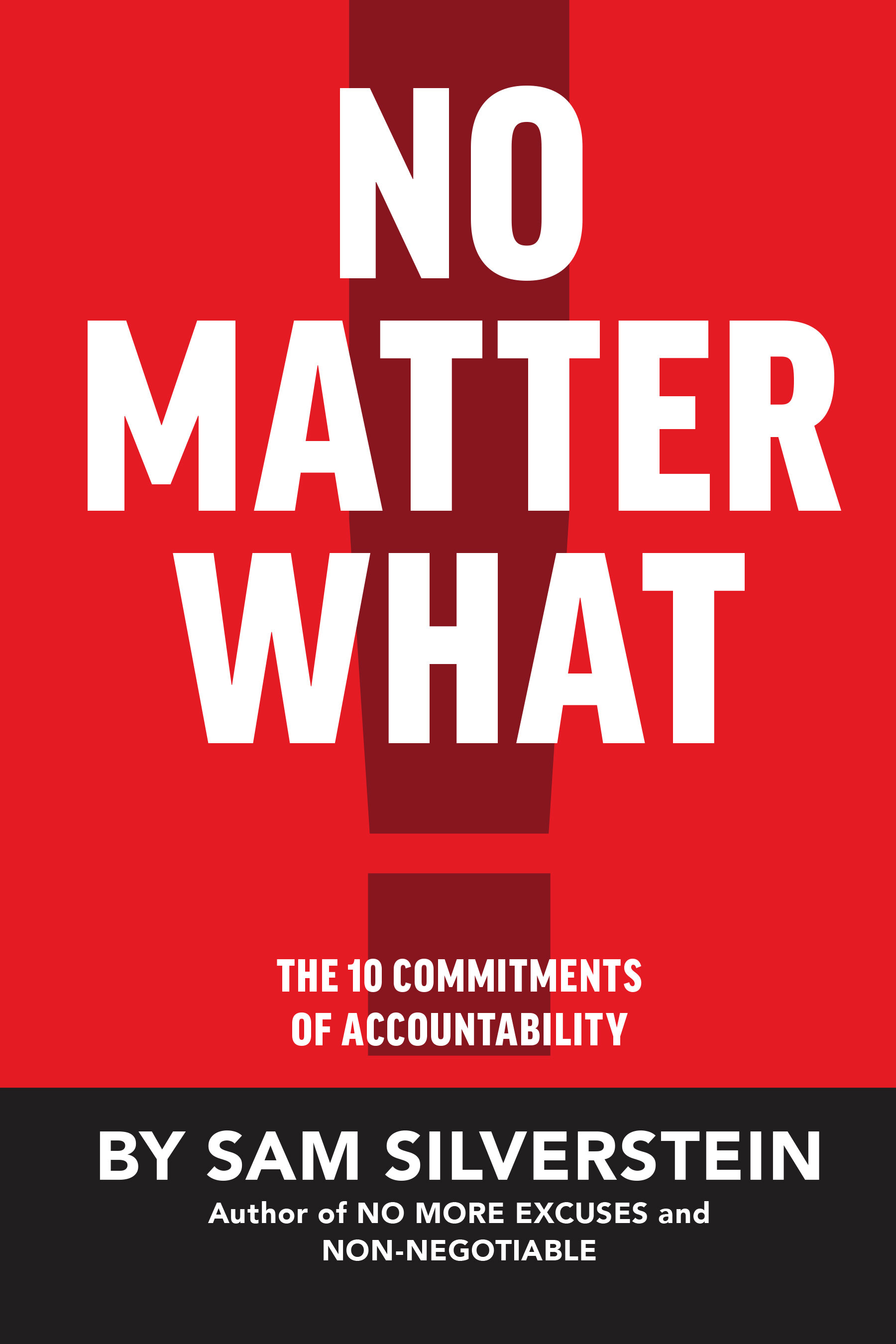
Sound Wisdom Blog
Transforming the Diversity Conversation…the Accountable Thing to Do by Sam Silverstein
Viewing people differently because of race, religion, gender, sexuality, physical attributes, ability, or personal style choices means you will always miss out on seeing their true potential. When leaders do this and/or enable others to do this, they not only make the workplace feel unsafe; they rob the people they lead of a more promising future…and they rob their organization of talent, ideas, and a better-looking bottom line. A leader can never lead a person to their true potential if that leader sees only superficial differences and false limitations.
Most leaders miss a huge opportunity when they talk about diversity.
In the wake of multiple high-profile news stories about diversity and inclusion, and any number of hastily assembled “damage control” initiatives from companies at the center of those stories, I wonder if it’s time to reframe our national workplace conversation on diversity.
Here’s a start: If you’re a leader, you are already accountable to each member of your team to fulfill your organization’s commitment to provide employees with a safe place to work—not just physically safe, but emotionally safe as well. That’s non-negotiable, and yes, your commitment to diversity is part of that commitment.
If you have any doubts about what you’ve just read, try looking at the question this way: Is there any way any member of your team will be able to contribute to your organization at an optimum level if they don’t feel safe at work? Of course not. As the leader, you cannot mandate creativity, teamwork, customer service, and accountability. You can only create a safe place that allows those elements to flourish naturally and to their very highest potential. Employees will always want to go to a safe place; it’s simple human nature to seek out the feeling of safety. Whenever your people look forward to going to work because they feel safe as they pursue the organization’s mission, you have created a powerful competitive advantage. Whenever they don’t, you haven’t. It’s that simple.
Some leaders will say, “But, Sam, this isn’t the home. This is the workplace.” My response would be, “Do you want the very best out of your people, or do you want half or three-quarters of what they can do?”
I would follow up with this question: “How safe do you imagine someone feels at work when they see evidence, reinforced day in and day out, that they fall into the category of ‘second class—not because of their performance, but because of who someone else thinks they are?” The answer is: Not very safe at all.
Viewing people differently because of race, religion, gender, sexuality, physical attributes, ability, or personal style choices means you will always miss out on seeing their true potential. When leaders do this and/or enable others to do this, they not only make the workplace feel unsafe; they rob the people they lead of a more promising future…and they rob their organization of talent, ideas, and a better-looking bottom line. A leader can never lead a person to their true potential if that leader sees only superficial differences and false limitations.
Which brings us back to the diversity conversation. Most leaders miss a huge opportunity when they talk about diversity…which means most organizations miss that opportunity.
Here’s what I mean by that. Most company leaders wait until there is a major problem, some kind of triggering incident, to start talking about diversity and making it a priority. That’s essentially reactive! Why not be proactive? Why wait for a crisis?
The typical reactive approach we see from top management has a troubling ripple effect. It leads to a predictable “do-I-really-have-to” attitude towards diversity initiatives in general. Because diversity only shows up as a meaningful priority when there’s a potential problem, people tend to think (and, yes, say out loud) things like, “Too bad I have to go to diversity training tomorrow”—as though the training session were some kind of a distraction from their real job.
That’s how most people think of diversity training: as part of a public relations initiative. And unfortunately, all too often, that’s just what it is!
Here’s my point: getting a clearer sense of what it takes to make everyone in the workplace feel safe can’t be just a PR stunt. It has to be how you do business. It must be what you believe.
Understanding what makes our people feel safe must be part of our leadership strategy for our teams and for the organization as a whole. Why? Because diversity training affords us as leaders the opportunity to better understand more people.
If we can better understand more people, we can connect with more people.
If we can connect with more people, we have the ability to serve more people.
The more people we truly understand and connect with and figure out how to serve, the more people we can make meaningful commitments to.
And you know what else? When we build deeper relationships with our people, when we have an understanding of how best to serve them at a high level, and we make personal commitments to them, then we are naturally going to be more accountable to them…and in the process we will be creating an environment where they’re inspired to be accountable to us.
Which is what we really want!
So here’s what this all adds up to: Diversity, when approached properly, as an ongoing priority, isn’t a distraction from our real job. It’s one of the keys to building an accountable organization. For every single one of us, starting at the top, diversity is part of our real job, every single day! Not only that: It’s a major competitive advantage, waiting to be claimed…and we need to start treating it that way.
For more on this important topic, see Sam Silverstein’s book No Matter What: The 10 Commitments of Accountability. Sam is dedicated to empowering people to live accountable lives, transform the way they do business, and create a more accountable world. He helps companies create an organizational culture that prioritizes and inspires accountability. You can follow Sam on Twitter, Facebook, Instagram, and YouTube. This post originally appeared here on The Accountability Blog.
How to Build a More Inclusive Workplace by Jennifer Janechek
Martin Luther King, Jr. reminds us that the American dream is possible only insofar as every human being has an equal opportunity to find meaningful work. In his lesser-known speech to the Fourth Constitutional Convention of the AFL-CIO, given in December 1961, King says:
I look forward confidently to the day when all who work for a living will be one, with no thought to their separateness as Negroes, Jews, Italians, or any other distinctions. This will be the day when we bring into realization the American Dream—a dream yet unfulfilled. A dream of equality of opportunity, of privilege and property widely distributed…. The dream of a country where every man will respect the dignity and worth of human personality—that is the dream.
While many companies today tout diversity as a hiring value, not all organizations support their diversity efforts by cultivating an inclusive workplace. Below are six important strategies for creating a more positive, equitable experience for employees.
Photo by New York World-Telegram and the Sun staff photographer Dick DeMarsico
Martin Luther King, Jr. reminds us that the American dream is possible only insofar as every human being has an equal opportunity to find meaningful work. In his lesser-known speech to the Fourth Constitutional Convention of the AFL-CIO, given in December 1961, King says:
I look forward confidently to the day when all who work for a living will be one, with no thought to their separateness as Negroes, Jews, Italians, or any other distinctions. This will be the day when we bring into realization the American Dream—a dream yet unfulfilled. A dream of equality of opportunity, of privilege and property widely distributed…. The dream of a country where every man will respect the dignity and worth of human personality—that is the dream.
While many companies today tout diversity as a hiring value, not all organizations support their diversity efforts by cultivating an inclusive workplace. Below are six important strategies for creating a more positive, equitable experience for employees.
Make inclusivity a core value.
Incorporate inclusivity into your organization’s core values. As Sam Silverstein writes in The Accountability Circle, “Your Values embody your principles and your standards of behavior.… Values determine how we see, connect to, and treat other people. They are the foundation for the relationships we build with the people in our world.” Inclusivity should be your standard of behavior—your “House Rules” that apply everywhere, at all times. By integrating inclusivity into your organization’s core values, you ensure that all team members understand that equity, accessibility, and mutual respect must characterize all interactions—for employees, clients, and everyone in between.Create safe spaces.
Offer clear venues for expressing concerns, wants, and needs without fear of retaliation or discrimination. Designate certain areas of the office for personal needs (e.g., lactation rooms).Practice inclusive communication.
Avoid ableist, sexist, racist, and otherwise discriminatory language; off-color jokes; and identity-based stereotypes. Create opportunities for people to share their identification preferences. Send content in an accessible manner as a rule, not just for those who request it.Amplify underrepresented voices.
Ensure that underrepresented groups are not marginalized within your organization by giving them the platform to share their ideas and never speaking on their behalf. Amplify these voices by listening attentively, confirming and reiterating the points made, and creating opportunities for follow-up.Invite regular feedback.
Provide different forums for employees to share feedback on their experience within the organization. Ideally, there should be one-on-one, small-group, and anonymous (digital) feedback mechanisms. Welcoming and fostering dialogue about team members’ experiences will help strengthen the organizational culture and ensure that everyone feels valued and able to contribute equally.Encourage education in DEI.
Prioritize training in diversity, equity, and inclusion. Host diversity training workshops. Organize employee study groups around DEI-focused books, such as Jess Pettitt’s Good Enough Now. When you provide concrete means for employees to educate themselves in diversity and inclusion, you will shift the culture of your entire organization in powerful ways.
Jennifer Janechek is the director of content strategy for Sound Wisdom and the founder of Work–Home–Life, an online magazine and virtual community for remote and hybrid workers, freelancers, digital nomads, and entrepreneurs with home offices. She is also the host of The Sound Wisdom Podcast, which you can watch on the Sound Wisdom YouTube channel or listen to on Anchor or wherever you listen to podcasts!





